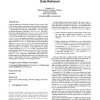378 search results - page 3 / 76 » Learning to Rank with Supplementary Data |
SIGIR
2008
ACM
13 years 5 months ago
2008
ACM
Ranking algorithms, whose goal is to appropriately order a set of objects/documents, are an important component of information retrieval systems. Previous work on ranking algorith...
ICML
2007
IEEE
14 years 5 months ago
2007
IEEE
Cluster analysis of ranking data, which occurs in consumer questionnaires, voting forms or other inquiries of preferences, attempts to identify typical groups of rank choices. Emp...
ICDE
2008
IEEE
13 years 11 months ago
2008
IEEE
— Learning to rank has become a popular method for web search ranking. Traditionally, expert-judged examples are the major training resource for machine learned web ranking, whic...
KDD
2005
ACM
14 years 5 months ago
2005
ACM
Learning ranking (or preference) functions has been a major issue in the machine learning community and has produced many applications in information retrieval. SVMs (Support Vect...
WSDM
2010
ACM
14 years 2 months ago
2010
ACM
In information retrieval, relevance of documents with respect to queries is usually judged by humans, and used in evaluation and/or learning of ranking functions. Previous work ha...

